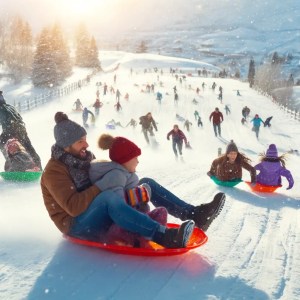- Introduction to a Journey into the Heart of Christmas: A Tale of Time-Honored Traditions
- Pagan Roots and Early Celebrations
- The Birth of Christ and the Early Christian Era
- Medieval Christmas: A Blend of Sacred and Secular
- Renaissance and Reformation: Changing Perspectives
- Victorian Era: The Making of Modern Christmas
- 20th Century: Commercialization and Global Traditions
- Christmas During Wartime
- Contemporary Christmas: A Fusion of Cultures
- The Future of Christmas Traditions
- Conclusion to Embracing the Eternal Spirit of Christmas: Reflections and Revelations
Introduction to a Journey into the Heart of Christmas: A Tale of Time-Honored Traditions
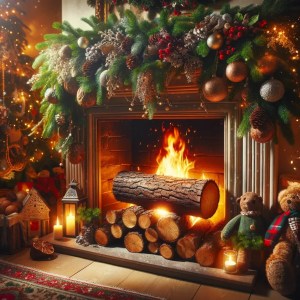
The Essence of Christmas Traditions
In the heart of winter’s embrace, where frost paints the windows and hearths blaze with welcoming warmth, lies the enigmatic and ever-evolving celebration of Christmas. This festivity, more than just a seasonal holiday, is a mosaic of traditions, each piece a fragment of history, carrying the whispers of centuries past. Our foray into the history and evolution of Christmas traditions is akin to unwrapping a time-worn yet glittering package, revealing the layers of cultural, religious, and societal influences that have shaped this beloved global celebration.
Journey Through Time
As we delve into this rich tapestry, we travel across epochs, from the ancient whispers of pagan festivals to the resounding chimes of the modern Christmas. This historical odyssey uncovers the symbiosis of traditions, where ancient rites blend with medieval jubilations, and Victorian innovations give way to contemporary practices. In this exploration, each era unfurls its own unique contribution, weaving a complex yet captivating narrative that has come to define the Christmas we know and love today.
Pagan Roots and Early Celebrations
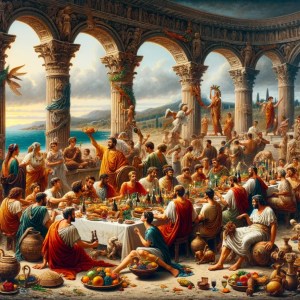
Winter Solstice and Its Significance
Long before Christmas found its footing in the Christian calendar, ancient civilizations revered the winter solstice. This astronomical phenomenon, heralding the longest night of the year, was seen as a pivotal point of renewal and rebirth. Cultures from the Norse celebrating Yule, with their great Yule logs, to the Romans with Saturnalia, a time of merriment and social reversal, all recognized this time as significant. These early festivities laid the foundational ethos of warmth, light, and community that continue to echo in our Christmas celebrations.
Roman Saturnalia and its Influence
The Roman festival of Saturnalia, a week-long period of lawlessness celebrated between December 17-25, stood as a precursor to many Christmas customs. During this time, Roman courts were closed, and Roman law dictated that no one could be punished for damaging property or injuring people. The festival also involved the exchange of gifts, particularly wax candles and clay figurines, which may have influenced later Christmas traditions.
The Birth of Christ and the Early Christian Era
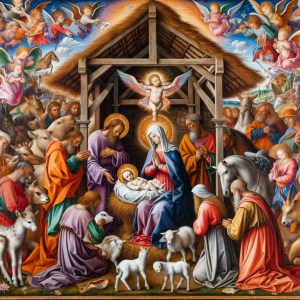
The Integration of Pagan Customs
As Christianity spread across Europe, early Church leaders, aiming to ease pagan converts into their faith, began to adopt and adapt several pagan customs. The celebration of the birth of Christ was strategically placed in alignment with these existing winter festivals. This integration was not merely coincidental but a deliberate effort to replace pagan rituals with Christian meaning while maintaining the communal and celebratory spirit that marked these ancient festivals.
The Emergence of the December 25th Celebration
The choice of December 25th for celebrating the birth of Christ, a date close to the winter solstice and the Roman Saturnalia, was pivotal in shaping Christmas. This date, first mentioned in the Roman almanac, Chronography of 354, was part of a strategy to Christianize popular pagan festivals. The adoption of this date marked the beginning of Christmas as a distinctively Christian celebration while retaining elements of its pagan heritage.
Medieval Christmas: A Blend of Sacred and Secular
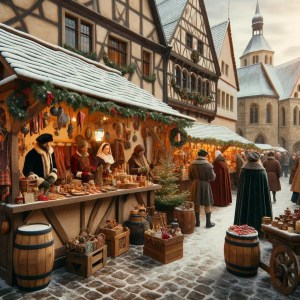
Feasts and Festivities
The medieval Christmas was a spectacle of both sacred and secular elements. The period, spanning from December 24th to January 6th, was marked by religious observances and vibrant festivities. Feasts were central to the celebration, with extravagant dishes and communal eating symbolizing abundance and fellowship. This era also saw the inception of Christmas markets, bringing together communities in the spirit of festive trading and merrymaking.
Yule Logs and Carols
Two enduring medieval traditions are the burning of the Yule log and the singing of carols. The Yule log, a large piece of wood chosen and brought into the house with great ceremony, was meant to burn continuously throughout the Twelve Days of Christmas, symbolizing light and warmth. Meanwhile, caroling, originally a form of communal folk singing during celebrations, evolved into a practice of singing songs specifically about the nativity and Christ’s birth.
Renaissance and Reformation: Changing Perspectives
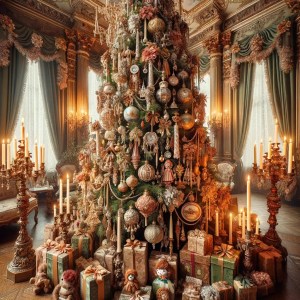
The Impact of Protestant Reformation
The Protestant Reformation brought significant changes to how Christmas was celebrated. Reformers like Martin Luther sought to remove what they saw as pagan influences from Christian practices. This led to a more subdued celebration of Christmas in many Protestant regions, with an emphasis on religious piety over communal festivity. However, in some areas, particularly in Germany, new traditions like the advent wreath began to emerge.
Renaissance Art and Christmas Imagery
The Renaissance period witnessed an explosion of artistic expression that profoundly impacted Christmas imagery. The nativity scene, as depicted by artists like Leonardo da Vinci and Michelangelo, became a central visual theme of Christmas. These artistic renditions not only embellished the celebration but also helped in disseminating the biblical story of Christ’s birth to a broader audience.
Victorian Era: The Making of Modern Christmas
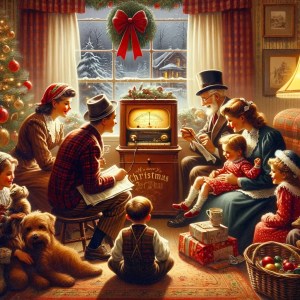
The Introduction of Christmas Trees
The modern Christmas tree, as we know it, owes its widespread popularity to the Victorian era. While the tradition of bringing evergreens into homes dates back to ancient times, it was Queen Victoria and Prince Albert who popularized the decorated Christmas tree in England. This tradition, symbolizing life and vigor amidst the winter bleakness, rapidly spread across Europe and the Americas, becoming a quintessential emblem of Christmas celebration.
The Evolution of Santa Claus
The Victorian era also witnessed the transformation of Santa Claus from a bishop-like figure into the jolly, red-suited icon of Christmas. This evolution was influenced by various cultural depictions, including the Dutch Sinterklaas and the English Father Christmas. The character of Santa Claus, as refined during this era, became a symbol of generosity and merriment, embodying the spirit of Christmas giving.
20th Century: Commercialization and Global Traditions

The Rise of Consumerism
The 20th century marked the onset of the commercialization of Christmas. The festive season became a significant economic driver, with businesses capitalizing on the spirit of giving through advertising and marketing campaigns. This commercial aspect led to a proliferation of gift-giving, turning Christmas into a major retail event, while also spurring the creation of new traditions like Black Friday sales.
Adoption and Adaptation Worldwide
As Christmas traditions spread globally, they were adopted and adapted to fit various cultural contexts. Countries around the world embraced elements of the Christmas celebration, blending them with their own customs and practices. From Japan’s Christmas KFC meals to the Philippines’ star-shaped lanterns, the global spread of Christmas demonstrates its universal appeal and adaptability.
Christmas During Wartime
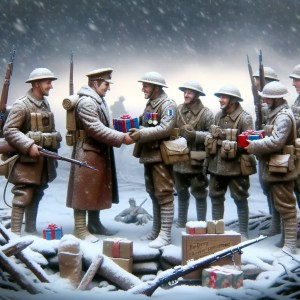
Impact of Wars on Christmas Celebrations
Wars have historically cast a shadow over Christmas celebrations, altering them in profound ways. During both World Wars, Christmas became a time of poignant reflection and a temporary reprieve from the horrors of conflict. Stories of Christmas truces, such as the famous 1914 Western Front ceasefire, highlight the holiday’s power to foster brief moments of peace and camaraderie amidst turmoil.
Tales of Truce and Unity
These wartime Christmases also spawned tales of resilience and unity. Soldiers away from home created makeshift celebrations, sharing rations and singing carols across enemy lines. These instances not only reflect the enduring spirit of Christmas but also serve as poignant reminders of the common humanity that persists even in the darkest of times.
Contemporary Christmas: A Fusion of Cultures

Technology and Christmas
In the contemporary world, technology has reshaped the way we celebrate Christmas. From e-cards and virtual gatherings to online shopping and light displays synchronized to music, technology has enhanced and facilitated Christmas traditions, making them more accessible and diverse. It has also enabled people to connect and share their festive experiences globally, fostering a sense of global community.
The Diverse Ways of Celebrating
Today’s Christmas is a melting pot of traditions, reflecting the multicultural fabric of our society. Celebrations vary widely, from the Midnight Masses and posadas in Latin America to the festive markets in Europe and the summer Christmas barbecues in Australia. This diversity in celebration not only enriches the holiday but also signifies the universal joy and togetherness that Christmas brings.
The Future of Christmas Traditions

Sustainable Celebrations
As we look towards the future, sustainability becomes a crucial aspect of Christmas celebrations. There is a growing awareness of the environmental impact of holiday practices, from tree cutting to energy consumption for lighting. Future traditions might see a shift towards more eco-friendly practices, such as using renewable resources and minimizing waste, ensuring that the joy of Christmas is preserved for generations to come.
Keeping Traditions Alive in the Digital Age
In the digital age, preserving and passing down Christmas traditions becomes both a challenge and an opportunity. While technology offers new ways to celebrate and share these customs, there’s a growing desire to maintain the personal and communal aspects of the holiday. Balancing technological advancements with the traditional essence of Christmas will be key to keeping these age-old traditions alive and relevant.
Conclusion to Embracing the Eternal Spirit of Christmas: Reflections and Revelations
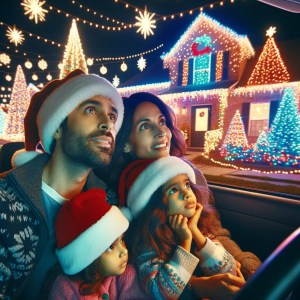
Reflecting on the Evolution
Our journey through the history and evolution of Christmas traditions reveals a fascinating mosaic of change and continuity. From ancient solstice celebrations to modern digital festivities, Christmas has continually adapted, reflecting the shifting sands of history, culture, and technology. This evolution underscores the holiday’s enduring appeal and its ability to resonate across different eras and societies.
The Timeless Spirit of Christmas
Despite the myriad changes and adaptations, the core spirit of Christmas – a time of joy, giving, and togetherness – remains unaltered. This spirit, transcending time and place, is the thread that weaves through the tapestry of Christmas traditions, binding them into a vibrant and enduring celebration. As we embrace this festive season, we not only partake in these age-old customs but also contribute to the ongoing story of Christmas, a story that continues to unfold and enchant with each passing year.
Join the Simply Sound Society Forum
A Community of Shared Festivities and Insights
As we revel in the rich history and diverse celebrations of Christmas, it’s important to remember the power of community in keeping these traditions vibrant and meaningful. In the spirit of this togetherness, I extend a warm invitation to join the Simply Sound Society Forum, a platform where the joy of sharing and learning about life’s many facets, including holiday traditions, thrives.
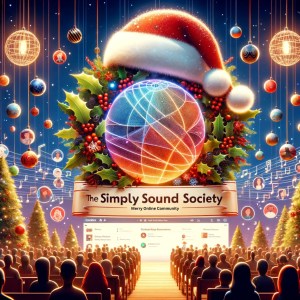
Engage, Share, and Grow Together
The Simply Sound Society Forum is more than just a space to exchange holiday recipes or decoration ideas. It’s a community where members can share their unique Christmas traditions, experiences, and insights, enriching each other’s celebrations. Whether you’re looking to discover new ways to celebrate Christmas sustainably, seeking advice on how to blend different cultural traditions, or simply wanting to share your festive joy, the forum provides a welcoming and supportive space for all.
A Forum for All Seasons
While Christmas is a time of heightened community spirit, the Simply Sound Society Forum is a resource and community that endures year-round. It’s a place where you can find support, advice, and camaraderie in all aspects of life, from wellness and relationships to finance and personal growth. By joining, you’re not just signing up for holiday discussions; you’re becoming part of a community that values sound advice and meaningful connections in every season.
How to Join
Becoming a member of the Simply Sound Society Forum is a straightforward process. Simply visit SimplySoundAdvice.com and navigate to the Simply Sound Society section. There, you’ll find an easy sign-up option to join our thriving community. Once you’re a member, you can start participating in discussions, sharing your stories, and gaining insights from a diverse group of individuals united in their quest for a richer, more connected life.
Your Voice Matters
In the Simply Sound Society Forum, every member’s voice is valued. Whether you’re a Christmas enthusiast with a trove of holiday traditions or someone seeking new ways to celebrate, your contributions help enrich our collective understanding and enjoyment of this festive season. Join us today, and let’s make this Christmas, and every day thereafter, a time of shared joy and meaningful connections.











